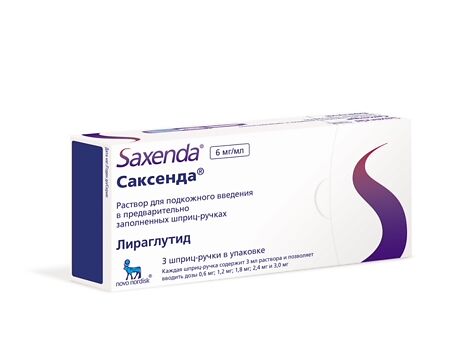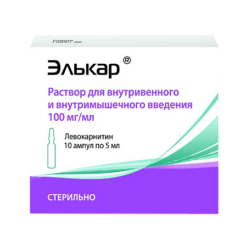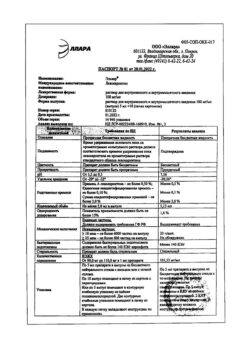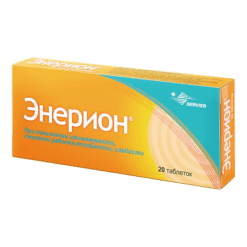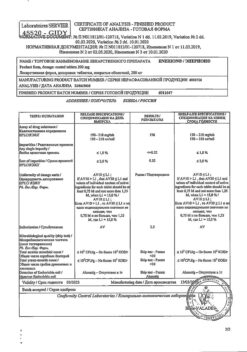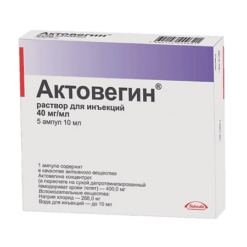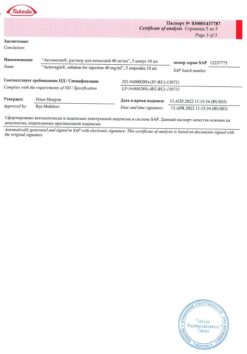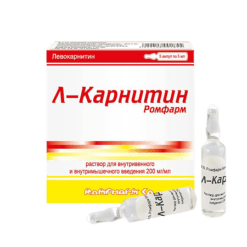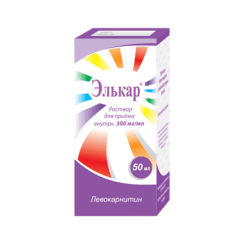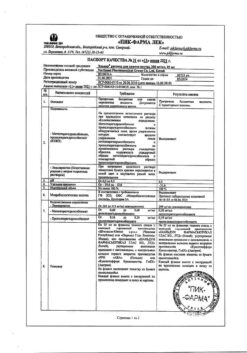No products in the cart.
Saxenda, 6 mg/ml 3 ml cartridges in syringe pens 3 pcs
€1.00
Out of stock
(E-mail when Stock is available)
Description
Pharmacotherapeutic group
Hypoglycemic agent – analog of glucagon-like peptide-1 (GFP-1).
ATC code: A10BJ02.
Pharmacological properties
Pharmacodynamics
. Saxenda® active substance, liraglutide, is an acylated human GFP-1 analog produced by recombinant DNA biotechnology using Saccharomyces cerevisiae strain, which has 97% amino acid sequence homology to endogenous human GFP-1. Liraglutide binds to and activates the GFP-1 receptor (GFP-1P). Liraglutide is resistant to metabolic breakdown; its half-life from plasma after subcutaneous administration is 13 h. The pharmacokinetic profile of liraglutide, which allows its administration to patients once daily, is the result of self-association, resulting in delayed absorption of the drug; binding to plasma proteins; and resistance to dipeptidyl peptidase-4 (DFP-4) and neutral endopeptidase (NEP).
PPP-1 is a physiological regulator of appetite and food intake, and PPP-1P is located in several brain regions involved in appetite regulation processes. In animal studies, peripheral administration of liraglutide resulted in drug uptake in specific brain regions, including the hypothalamus, where liraglutide through specific activation of GFP-1P increased satiety signals and attenuated hunger signals, thereby leading to weight loss.
GFP-1P is also present in specific areas of the heart, blood vessels, immune system and kidneys. In experiments on mice with atherosclerosis, liraglutide prevented further development of aortic plaques and reduced inflammation in them. In addition, liraglutide had a favorable effect on plasma lipids. Liraglutide did not reduce the size of existing plaques.
Liraglutide reduces body weight in humans primarily by reducing the weight of adipose tissue. The decrease in body weight is due to a decrease in food intake. Liraglutide does not increase 24-hour energy expenditure. Liraglutide regulates appetite by increasing the feeling of a full stomach and satiety, while reducing the feeling of hunger and reducing anticipated food intake.
Liraglutide stimulates insulin secretion and reduces unnecessarily high glucagon secretion in a glucose-dependent manner, and improves pancreatic beta cell function, resulting in lower fasting and post-meal glucose concentrations. The mechanism of glucose concentration reduction also includes a slight delay in gastric emptying.
In long-term clinical trials (LC) with the participation of overweight and obese patients, the use of Saxenda® in combination with a low-calorie diet and increased physical activity resulted in significant weight reduction.
Effects on appetite, caloric intake and energy expenditure, gastric emptying and glucose concentration at fasting and after meals
The pharmacodynamic effects of liraglutide were studied in a five-week pharmacological QI involving 49 obese patients (body mass index (BMI) 30-40 kg/m2) without diabetes mellitus (DM).
Appetite, caloric intake and energy expenditure
It is believed that body weight reduction with Saxenda® is associated with regulation of appetite and food intake. Appetite was assessed before and within 5 h after a standardized breakfast; unrestricted food intake was assessed during the subsequent lunch. Compared with placebo, Saxenda® increased feeling of fullness and gastric filling after a meal and decreased feeling of hunger and estimated amount of estimated food intake, as well as decreased unrestricted food intake. No therapy-related increase in 24-hour energy expenditure was noted in the respiratory chamber assessment.
Gastric Emptying
Administration of Saxenda® resulted in a slight delay in gastric emptying during the first hour after ingestion, resulting in a decreased rate of glucose elevation as well as a decreased total blood glucose concentration after ingestion.
The fasting and postmeal glucose, insulin, and glucagon concentrations
The fasting and postmeal glucose, insulin, and glucagon concentrations were assessed before and within 5 h of standardized meal intake. Compared to placebo, Saxenda® decreased fasting and postprandial glucose concentrations (AUC0-60 min) during the first hour after a meal, and decreased the 5-hour AUC of glucose and the rising glucose concentration (AUC0-300 min). In addition, compared to placebo, Saxenda® decreased postprandial glucagon (AUC0-300 min) and insulin (AUC0-60 min) concentrations and incremental insulin concentration (iAUC0-60 min) after a meal.
Fasting glucose and insulin concentrations and incremental glucose and insulin concentrations were also assessed during an oral glucose tolerance test (IGT) with 75 g glucose before therapy and after 1 year of therapy in 3731 overweight and obese patients and with the presence or absence of prediabetes. Compared to placebo, Saxenda® decreased fasting glucose concentration and increasing glucose concentration. The effect was more pronounced in patients with prediabetes. In addition, compared to placebo, Saxenda® decreased fasting insulin concentration and increased increasing insulin concentration.
After 160 weeks of continued therapy with liraglutide 3.0 mg, the AUC of plasma glucose decreased, while when using placebo it remained unchanged. Additionally, insulin AUC remained relatively stable during the 160-week period of liraglutide 3.0 mg treatment, whereas a decrease was observed with placebo. All studied effects of the therapy were statistically significant in favor of liraglutide 3.0 mg.
Effects on fasting glucose concentration and rising glucose concentration in patients with type 2 diabetes mellitus (DM2) with overweight and obesity
. Compared to placebo, Saxenda® reduced fasting glucose concentration and mean rising postprandial glucose concentration (90 minutes after a meal, mean value for 3 meals per day).
Pancreatic Beta Cell Function
CIs of up to one year with Saxenda® in patients with overweight and with or without DM have demonstrated improved and maintained pancreatic beta cell function. This was shown using measurement methods such as the homeostatic beta cell function assessment model (NOMA-B) and the ratio of proinsulin to insulin concentrations.
Clinical efficacy and safety
. The efficacy and safety of Saxenda® for long-term body weight correction in combination with a low-calorie diet and increased physical activity was studied in 4 randomized, double-blind, placebo-controlled phase 3 SCALE studies involving a total of 5,358 adult patients.
Body weight
. Compared to placebo, Saxenda® achieved greater reductions in body weight in obese/overweight patients in all study groups, including those with or without prediabetes, DM2 and moderate to severe obstructive sleep apnea. In addition, among the study population, a greater proportion of patients achieved weight reductions ≥ 5% and ˃ 10% with Saxenda® compared to placebo. Significant weight loss was also observed in a CI in which patients achieved an average weight loss of 6.0% using a low-calorie diet for 12 weeks prior to treatment with Saxenda®. In this study, more patients maintained the weight loss achieved before treatment with Saxenda® compared to placebo (81.4% and 48.9%, respectively).
In the 160-week CI, patients who received Saxenda® achieved greater weight loss compared to patients who received placebo. Most of the weight loss occurred in the first year and was maintained for 160 weeks.
In the 160-week QI, the mean percent change in body weight and the proportion of patients achieving weight loss from baseline to 160 weeks by at least 5% and more than 10% were also significant compared to placebo.
Weight loss after 12 weeks of therapy with Saxenda® (liraglutide 3.0 mg)
In two trials lasting 56 weeks, 67.5% and 50.4% of patients achieved weight loss of at least 5% after 12 weeks of therapy with Saxenda® in a 3.0 mg dose. The average weight loss in these patients who completed the study was 11.2% compared to the baseline value. In patients who achieved a weight loss of less than 5% after 12 weeks of therapy at the dose of 3.0 mg and completed the study (1 year), the average weight loss was 3.8%.
Glycemic control
Liraglutide therapy significantly improved glycemic parameters in the normoglycemic, prediabetes and DM2 subpopulations.
DM2 developed in 0.2% of patients treated with Saxenda® compared to 1.1% in the placebo group. 69.2% of patients with prediabetes reversed this condition with Saxenda® compared to 32.7% in the placebo group. At week 160, 3% of patients who received Saxenda® and 11% of patients who received placebo were diagnosed with DM2 while continuing treatment. Compared with placebo, the time to DM2 development was 2.7 times longer with liraglutide 3.0 mg and the relative risk (RR) of DM2 development with liraglutide was 0.2. At week 160 in the liraglutide 3.0 mg group, 65.9% of patients with prediabetes reversed this condition to normoglycemia compared with 36.3% in the placebo group.
In one study, 69.2% and 56.5% of obese and DM2 patients treated with Saxenda® achieved target HbA1c values of ˂ 7% and ≤6.5%, respectively, compared with 27.2% and 15.0% in patients treated with placebo.
Cardiometabolic parameters
Compared with placebo, Saxenda® significantly improved systolic blood pressure (BP), waist circumference and fasting lipid concentration.
In a 160-week CI, the mean reduction in waist circumference was 8.2 cm with Saxenda® and 4.0 cm with placebo; the reduction in systolic and diastolic BP was 4.3 mmHg and 1.5 mmHg with Saxenda® and 2.7 mmHg and 1.8 mmHg, respectively. when using placebo, respectively; LDL cholesterol concentration decrease was 3.1 mmol/L when using Saxenda® and 0.7 mmol/L when using placebo; HDL cholesterol concentration increase was 2.3 mmol/L when using Saxenda® and 0.5 mmol/L when using placebo.
Apnea-Hypnea Index (AHI)
Compared to placebo, a significant decrease in the severity of obstructive sleep apnea was observed with Saxenda®, as assessed by the change in AHI relative to the baseline value.
Immunogenicity
Due to the potential immunogenic properties of protein and peptide drugs, patients may develop antibodies to liraglutide after therapy with Saxenda®. In the CI, 2.5% of patients treated with Saxenda® developed antibodies to liraglutide. Antibody formation did not reduce the efficacy of Saxenda®.
Evaluation of cardiovascular events
Major cardiovascular events (MACEs) were evaluated by a panel of external independent experts and defined as nonfatal myocardial infarction, nonfatal stroke and cardiovascular-related death. In 5 double-blind controlled phase 2 and 3 CIs with Saxenda®, there were 6 BSSS in patients receiving Saxenda® and 10 BSSS in patients receiving placebo. The OR with 95% CI was 0.33 for Saxenda® versus placebo. In the phase 3 CI, the mean increase in heart rate (HR) was 2.5 beats per minute in patients receiving Saxenda®. The greatest increase in HR was observed after 6 weeks of therapy. This increase was reversible and disappeared after discontinuation of liraglutide therapy.
A multicenter, placebo-controlled, double-blind study, “Effect and Effects of Liraglutide in Diabetes Mellitus: Assessment of Cardiovascular Risk” (LEADER®) was conducted.
Liraglutide 1.8 mg also significantly reduced the risk of advanced BCCS (primary BCCS, unstable angina leading to hospitalization, myocardial revascularization, or hospitalization due to heart failure) and other secondary end points.
Children and adolescents
In a double-blind QI comparing the effectiveness and safety of Saxenda® versus placebo for weight loss in obese adolescents aged 12 years and older, Saxenda® was superior to placebo in reducing the standard deviation of BMI (measured to assess weight loss) after 56 weeks of treatment. More patients achieved ≥5% and ≥10% reductions in BMI on liraglutide therapy than patients receiving placebo, with greater reductions in mean BMI and body weight. During the 26 weeks of follow-up without use of the drug, a recovery in body weight was observed with Saxenda® compared to placebo (assessed as change in standard deviation of BMI)
Based on tolerability, for most patients (82.4%) the drug dose was increased and they continued to receive the 3.0 mg dose; for the remaining patients the dose was increased and they continued to receive the drug in the 2.4 mg to 0.6 mg dose range.
Patient-determined scores
The drug Saxenda®, compared with placebo, improved patient-determined scores on several measures. There was a significant improvement in overall scores on the Simplified Body Weight Questionnaire for Quality of Life (IWQoL-Lite) and on all scales of the SF-36 Quality of Life Questionnaire, indicating a positive effect on the physical and psychological components of quality of life.
Pharmacokinetics
absorption
Absorption of liraglutide after subcutaneous administration is slow, with a time to reach maximum concentration (tmax) of approximately 11 h after administration. In obese patients (BMI 30-40 kg/m2) the average equilibrium concentration of liraglutide (AUCτ/24) reaches approximately 31 nmol/L after administration of 3.0 mg liraglutide. In the dose range of 0.6 mg to 3.0 mg, liraglutide exposure increases in proportion to the dose. The absolute bioavailability of liraglutide after subcutaneous administration is approximately 55%.
Distribution
The average apparent volume of distribution after subcutaneous administration of liraglutide at a dose of 3.0 mg is 20-25 L (in persons with a body weight of approximately 100 kg). Liraglutide is largely bound to plasma proteins (> 98%).
Metabolism
For 24 h after administration of a single dose of [3H]liraglutide to healthy volunteers, unchanged liraglutide remained the major component in plasma. Two metabolites (≤ 9% and ≤ 5% of total plasma radioactivity) were detected.
Elimation
Liraglutide is metabolized endogenously like large proteins without involvement of any specific organ as the primary excretion route. After administering a dose of [3H]-liraglutide, unaltered liraglutide was not detected in the urine or feces. Only a minor portion of the administered radioactivity in the form of liraglutide metabolites was excreted by the kidneys or through the intestine (6% and 5%, respectively). The radioactivity is excreted by the kidneys or through the intestine mainly during the first 6-8 days and represents 3 metabolites.
The average clearance after subcutaneous administration of 3.0 mg liraglutide is approximately 0.9 1.4 L/h and the elimination half-life is approximately 13 h.
Special patient groups
Elderly patients
No dose adjustment for age is required. According to the results of a population pharmacokinetic analysis in overweight and obese patients aged 18 to 82 years, age had no clinically significant effect on the pharmacokinetics of liraglutide when administered subcutaneously at a dose of 3.0 mg.
Gender
Based on population pharmacokinetic analysis data, women have a 24% lower body weight-adjusted clearance of liraglutide after subcutaneous administration at a dose of 3.0 mg than men. Based on the drug response data, no gender-adjusted dose is required.
Ethnicity
. According to a population pharmacokinetic analysis that included data from studies in overweight and obese patients of Caucasoid, non-Hispanic, Asian, and Hispanic racial groups, ethnicity had no clinically significant effect on the pharmacokinetics of liraglutide when administered subcutaneously at the 3.0 mg dose.
Body weight
Exposure to liraglutide decreases with increasing baseline body weight. Administration of liraglutide at a dose of 3.0 mg daily provides adequate exposure in the body weight range of 60-234 kg, according to the evaluation of the response to systemic exposure to the drug in the CI. Exposure to liraglutide in patients with body weights greater than 234 kg was not studied.
Patients with hepatic impairment
The pharmacokinetics of liraglutide were evaluated in patients with varying degrees of hepatic impairment in a single-dose (0.75 mg) study. A 13-23% reduction in liraglutide exposure was observed in patients with mild to moderate hepatic impairment and a significant reduction in liraglutide exposure (44%) in patients with severe hepatic impairment (> 9 Child-Pugh score) compared to healthy volunteers.
Patients with renal impairment
In a single-dose study (0.75 mg), liraglutide exposure was lower in patients with renal impairment compared with individuals with normal renal function. Exposure to liraglutide was lower by 33%, 14%, 27%, and 26%, respectively, in patients with mild (creatinine clearance (CK) 50 to 80 mL/min), moderate (CK 30 to 50 mL/min), severe (CK < 30 mL/min), and in patients with end-stage renal failure requiring hemodialysis.
Children and adolescents
The pharmacokinetic properties of liraglutide 3.0 mg were evaluated in clinical studies in obese adolescents aged 12 years to 18 years (134 patients, body weight 62-178 kg). The exposure of liraglutide in adolescents aged 12 to 18 years was comparable to that observed in adult obese patients.
Pharmacokinetic properties were also evaluated in a clinical pharmacology study involving obese children aged 7 to 11 years (13 patients, body weight 54-87 kg). Exposure to liraglutide 3.0 mg in children aged 7 years to 11 years was comparable to that observed in adult patients after adjustment for body weight.
Indications
Indications
Adults
Saxenda® is indicated as an adjunct to a low-calorie diet and increased physical activity for long-term use to correct body weight in adult patients with BMI:
• ≥ 30 kg/m2 (obesity) or
• ≥ 27 kg/m2 to < 30 kg/m2 (overweight) with at least one weight-related comorbidity such as prediabetes, type 2 diabetes mellitus, hypertension, dyslipidemia, or obstructive sleep apnea.TeenagersSaxenda® can be used as an adjunct to a healthy diet and increased physical activity to correct body weight in adolescents aged 12 years and older c:
• body weight over 60 kg and
• obese (BMI corresponding to ≥30 kg/m2 for adults according to international thresholds) *
*IOTF BMI threshold for obesity by gender between ages 12 and 18.
Table 1. IOTF BMI cutoff for obesity by gender between ages 12 and 18.
Age
(number of years)
Body mass index
30 kg/m2
Male gender
Female gender
12
26.02
26.67
12.5
26.43
27.24
13
26.84
27.76
13.5
27.25
28.20
14
27.63
28.57
14.5
27.98
28.87
15
28.30
29.11
15.5
28.60
29.29
16
28.88
29.43
16.5
29.14
29.56
17
29.41
29.69
17.5
29.70
29.84
18
30.00
30.00
Pharmacological effect
Pharmacological effect
Pharmacotherapeutic group
The hypoglycemic agent is an analogue of glucagon-like peptide-1 (GLP-1).
ATX code: A10BJ02.
Pharmacological properties
Pharmacodynamics
The active ingredient of Saxenda®, liraglutide, is an acylated analogue of human GLP-1, produced by recombinant DNA biotechnology using the Saccharomyces cerevisiae strain, which has 97% amino acid sequence homology to endogenous human GLP-1. Liraglutide binds to and activates the GLP-1 receptor (GLP-1R). Liraglutide is resistant to metabolic degradation, its half-life from plasma after subcutaneous administration is 13 hours. The pharmacokinetic profile of liraglutide, allowing it to be administered to patients once a day, is the result of self-association, which results in delayed absorption of the drug; binding to plasma proteins; as well as resistance to dipeptidyl peptidase-4 (DPP-4) and neutral endopeptidase (NEP).
GLP-1 is a physiological regulator of appetite and food intake, and GLP-1R is located in several brain regions involved in appetite regulation. In animal studies, peripheral administration of liraglutide resulted in drug uptake into specific areas of the brain, including the hypothalamus, where liraglutide, through specific activation of GLP-1R, increased satiety signals and decreased hunger signals, thereby leading to weight loss.
GLP-1R is also present in specific areas of the heart, blood vessels, immune system and kidneys. In experiments on mice with atherosclerosis, liraglutide prevented the further development of aortic plaques and reduced inflammation in them. In addition, liraglutide had a beneficial effect on plasma lipids. Liraglutide did not reduce the size of existing plaques.
Liraglutide reduces body weight in humans primarily by reducing adipose tissue mass. Reducing body weight occurs by reducing food consumption. Liraglutide does not increase 24-hour energy expenditure. Liraglutide regulates appetite by increasing the feeling of fullness and satiety, while reducing the feeling of hunger and reducing expected food intake.
Liraglutide stimulates insulin secretion and reduces excessive glucagon secretion in a glucose-dependent manner, and also improves pancreatic beta cell function, which leads to a decrease in fasting and postprandial glucose concentrations. The mechanism for reducing glucose concentration also involves a slight delay in gastric emptying.
In long-term clinical studies (CT) involving overweight and obese patients, the use of Saxenda® in combination with a low-calorie diet and increased physical activity led to significant weight loss.
Effects on appetite, caloric intake and energy expenditure, gastric emptying and fasting and postprandial glucose concentrations
The pharmacodynamic effects of liraglutide were studied in a five-week pharmacological trial involving 49 obese patients (body mass index (BMI) 30-40 kg/m2) without diabetes mellitus (DM).
Appetite, calorie intake and energy expenditure
It is believed that weight loss when using Saxenda® is associated with regulation of appetite and amount of food consumed. Appetite was assessed before and for 5 hours after a standardized breakfast; ad libitum food intake was assessed during the subsequent lunch. Compared with placebo, Saxenda increased postprandial satiety and fullness and decreased hunger, estimated food intake, and unrestricted food intake. When assessed using a respiratory chamber, no treatment-related increase in 24-hour energy expenditure was noted.
Gastric emptying
The use of Saxenda® led to a slight delay in gastric emptying during the first hour after ingestion, resulting in a decrease in the rate of increase in glucose concentrations, as well as the total blood glucose concentration after meals.
Fasting and postprandial glucose, insulin and glucagon concentrations
Fasting and postprandial glucose, insulin, and glucagon concentrations were assessed before and for 5 hours after a standardized meal. Compared with placebo, Saxenda® reduced fasting and postprandial glucose concentrations (AUC0-60 min) during the first hour after a meal, and also reduced 5-hour glucose AUC and rising glucose concentrations (AUC0-300 min). In addition, compared with placebo, Saxenda® reduced postprandial concentrations of glucagon (AUC0-300 min) and insulin (AUC0-60 min) and increasing insulin concentrations (iAUC0-60 min) after meals.
Fasting and progressive glucose and insulin concentrations were also assessed during an oral glucose tolerance test (OGTT) with 75 g glucose before and after 1 year of therapy in 3731 overweight and obese patients with or without prediabetes. Compared with placebo, Saxenda® reduced fasting and rising glucose concentrations. The effect was more pronounced in patients with prediabetes. In addition, compared with placebo, Saxenda® decreased fasting insulin concentrations and increased cumulative insulin concentrations.
After 160 weeks of continued treatment with liraglutide 3.0 mg, plasma glucose AUC decreased while it remained unchanged with placebo. Additionally, insulin AUC remained relatively stable during the 160-week treatment period with liraglutide 3.0 mg, whereas a decrease was observed with placebo. All studied effects of the therapy were statistically significant in favor of liraglutide 3.0 mg.
Effect on fasting glucose concentration and increasing glucose concentration in patients with type 2 diabetes mellitus (T2DM) with overweight and obesity
Compared with placebo, Saxenda® reduced fasting glucose concentrations and mean rising postprandial glucose concentrations (90 minutes after a meal, average for 3 meals per day).
Pancreatic beta cell function
CTs lasting up to one year with the use of Saxenda® in patients with excess body weight, as well as with or without diabetes, demonstrated improvement and preservation of pancreatic beta-cell function. This has been demonstrated using measurement methods such as the homeostatic model of assessment of beta-cell function (HOMA-B) and the ratio of proinsulin to insulin concentrations.
Clinical efficacy and safety
The effectiveness and safety of Saxenda® for long-term weight loss in combination with a low-calorie diet and increased physical activity was studied in 4 randomized, double-blind, placebo-controlled phase 3 SCALE studies, including a total of 5358 adult patients.
Body weight
Compared with placebo, Saxenda® achieved greater weight loss in obese/overweight patients in all study groups, including those with or without prediabetes, T2DM, and moderate to severe obstructive sleep apnea. Additionally, among the study population, a greater proportion of patients achieved weight loss of ≥ 5% and ˃ 10% with Saxenda compared to placebo. Significant weight loss was also observed in the trial, in which patients achieved an average weight loss of 6.0% on a low-calorie diet during the 12 weeks prior to treatment with Saxenda®. In this study, more patients maintained the weight loss achieved before treatment with Saxenda® compared to placebo (81.4% and 48.9%, respectively).
In a 160-week CT, patients receiving Saxenda® achieved greater weight loss compared to patients receiving placebo. Most weight loss occurred in the first year and was maintained for 160 weeks.
In the 160-week CT, the mean percentage change in body weight and the proportion of patients achieving weight loss from baseline to week 160 of at least 5% and greater than 10% were also significant compared with placebo.
Weight loss after 12 weeks of therapy with Saxenda® (liraglutide 3.0 mg)
In two 56-week studies, after 12 weeks of treatment with Saxenda 3.0 mg, 67.5% and 50.4% of patients achieved a weight loss of at least 5%. The mean weight loss in these patients who completed the study was 11.2% from baseline. In patients who achieved a weight loss of less than 5% after 12 weeks of therapy at a dose of 3.0 mg and completed the study (1 year), the average weight loss was 3.8%.
Glycemic control
Treatment with liraglutide significantly improved glycemic parameters in subpopulations with normoglycemia, prediabetes and T2DM.
T2DM developed in 0.2% of patients receiving Saxenda®, compared to 1.1% in the placebo group. 69.2% of patients with prediabetes experienced reversal of this condition when using Saxenda® compared to 32.7% in the placebo group. At week 160, during treatment continuation, T2DM was diagnosed in 3% of patients receiving Saxenda® and 11% of patients receiving placebo. Compared with placebo, the time to development of T2DM with liraglutide 3.0 mg was 2.7 times longer, and the relative risk (RR) of developing T2DM with liraglutide was 0.2. At week 160, 65.9% of patients with prediabetes had reversed to normoglycemia in the liraglutide 3.0 mg group compared with 36.3% in the placebo group.
In one study, 69.2% and 56.5% of obese patients with T2DM treated with Saxenda achieved target HbA1c values of ≤ 7% and ≤ 6.5%, respectively, compared with 27.2% and 15.0% of patients receiving placebo.
Cardiometabolic parameters
Compared with placebo, Saxenda® significantly improved systolic blood pressure (BP), waist circumference, and fasting lipid concentrations.
In a 160-week CT, the mean reduction in waist circumference was 8.2 cm with Saxenda® and 4.0 cm with placebo; the decrease in systolic and diastolic blood pressure was 4.3 mm Hg. and 1.5 mm Hg. when using the drug Saxenda® and 2.7 mm Hg. and 1.8 mm Hg. when using placebo, respectively; the decrease in LDL cholesterol concentration was 3.1 mmol/l when using Saxenda® and 0.7 mmol/l when using placebo; the increase in HDL cholesterol concentration was 2.3 mmol/l when using Saxenda® and 0.5 mmol/l when using placebo.
Apnea-hypnea index (AHI)
Compared with placebo, Saxenda® showed a significant reduction in the severity of obstructive sleep apnea, as assessed by changes in AHI relative to baseline.
Immunogenicity
Due to the potential immunogenic properties of protein and peptide drugs, patients may develop antibodies to liraglutide after therapy with Saxenda®. In the clinical trial, 2.5% of patients receiving Saxenda® developed antibodies to liraglutide. The formation of antibodies did not lead to a decrease in the effectiveness of Saxenda®.
Assessment of cardiovascular events
Major cardiovascular events (MCEs) were assessed by a panel of external independent experts and defined as non-fatal myocardial infarction, non-fatal stroke and death due to cardiovascular disease. In 5 double-blind, phase 2 and 3 controlled trials using Saxenda®, 6 FSHRs were observed in patients receiving Saxenda® and 10 FSHRs in patients receiving placebo. The RR with 95% CI was 0.33 with Saxenda compared with placebo. In the phase 3 CT, the average increase in heart rate (HR) was 2.5 beats per minute in patients receiving Saxenda®. The greatest increase in heart rate was observed after 6 weeks of therapy. This increase was reversible and disappeared after discontinuation of liraglutide therapy.
The Liraglutide Effect and Impact in Diabetes Mellitus: Cardiovascular Risk Assessment (LEADER®) trial was conducted in a multicenter, placebo-controlled, double-blind trial.
Liraglutide 1.8 mg also significantly reduced the risk of advanced ACE events (primary ACE events, unstable angina leading to hospitalization, myocardial revascularization, or hospitalization for heart failure) and other secondary endpoints.
Children and teenagers
In a double-blind trial comparing the efficacy and safety of Saxenda® versus placebo for weight loss in obese adolescents aged 12 years and older, Saxenda® was superior to placebo in reducing the standard deviation of BMI (measured to assess weight loss) after 56 weeks of treatment. More patients achieved ≥5% and ≥10% reductions in BMI on liraglutide therapy than patients receiving placebo, with greater reductions in mean BMI and body weight. During 26 weeks of drug-free follow-up, weight gain was observed with Saxenda® compared to placebo (measured as change in standard deviation of BMI)
Based on tolerability, for the majority of patients (82.4%), the dose of the drug was increased and they continued to receive a dose of 3.0 mg, for the remaining patients the dose was increased and they continued to receive the drug in the dose range from 2.4 mg to 0.6 mg.
Patient Measurement Results
Saxenda® improved patient-reported scores on several measures compared to placebo. There was a significant improvement in overall scores on the Inventory of Weight on Quality of Life-Lite (IWQoL-Lite) and on all scales of the SF-36 Quality of Life Questionnaire, indicating a positive impact on the physical and psychological components of quality of life.
Pharmacokinetics
Suction
Absorption of liraglutide after subcutaneous administration occurs slowly, the time to reach maximum concentration (tmax) is about 11 hours after administration. In obese patients (BMI 30-40 kg/m2), after administration of liraglutide at a dose of 3.0 mg, the mean steady-state concentration of liraglutide (AUCτ/24) reaches approximately 31 nmol/l. Over the dose range of 0.6 mg to 3.0 mg, liraglutide exposure increases proportionally to dose. The absolute bioavailability of liraglutide after subcutaneous administration is approximately 55%.
Distribution
The average apparent volume of distribution after subcutaneous administration of liraglutide at a dose of 3.0 mg is 20-25 l (in persons weighing about 100 kg). Liraglutide is highly bound to plasma proteins (>98%).
Metabolism
For 24 hours after administration of a single dose of [3H] liraglutide to healthy volunteers, unchanged liraglutide remained the main component in plasma. 2 metabolites were detected (≤ 9% and ≤ 5% of the level of total radioactivity in the blood plasma).
Removal
Liraglutide is metabolized endogenously like large proteins without the participation of any specific organ as the main route of elimination. Following dosing of [3H]-liraglutide, unchanged liraglutide was not detected in urine or feces. Only a small part of the administered radioactivity in the form of liraglutide metabolites was excreted by the kidneys or through the intestines (6% and 5%, respectively). Radioactive substances are excreted by the kidneys or through the intestines, mainly during the first 6–8 days and represent 3 metabolites.
The average clearance after subcutaneous administration of 3.0 mg of liraglutide is approximately 0.9 to 1.4 L/h, and the half-life is approximately 13 hours.
Special patient groups
Elderly patients
No dose adjustment is required based on age. According to the results of a population pharmacokinetic analysis in overweight and obese patients aged 18 to 82 years, age did not have a clinically significant effect on the pharmacokinetics of liraglutide when administered subcutaneously at a dose of 3.0 mg.
Gender
Based on data from a population pharmacokinetic analysis, the body weight-adjusted clearance of liraglutide after subcutaneous administration at a dose of 3.0 mg is 24% less in women than in men. Based on response data to the drug, no dose adjustment is required based on gender.
Ethnicity
According to the results of a population pharmacokinetic analysis, which included data from studies in overweight and obese patients of Caucasian, Black, Asian and Hispanic racial groups, ethnicity did not have a clinically significant effect on the pharmacokinetics of liraglutide when administered subcutaneously at a dose of 3.0 mg.
Body weight
Liraglutide exposure decreases with increasing initial body weight. The use of liraglutide at a dose of 3.0 mg daily provides adequate exposure in the body weight range of 60-234 kg, as assessed by the response to systemic exposure of the drug in CT. Liraglutide exposure has not been studied in patients weighing more than 234 kg.
Patients with liver failure
The pharmacokinetics of liraglutide were assessed in patients with varying degrees of hepatic impairment in a single dose study (0.75 mg). There was a 13-23% reduction in liraglutide exposure in patients with mild to moderate hepatic impairment and a significant reduction in liraglutide exposure (by 44%) in patients with severe hepatic impairment (Child-Pugh score > 9) compared to healthy volunteers.
Patients with renal failure
In a single dose (0.75 mg) study, liraglutide exposure was lower in patients with renal impairment compared with those with normal renal function. Liraglutide exposure was lower by 33%, 14%, 27% and 26%, respectively, in patients with mild renal failure (creatinine clearance (CR) 50 – 80 ml/min), moderate (CR 30 – 50 ml/min), severe (CR < 30 ml/min) and in patients with end-stage renal failure requiring treatment. hemodialysis.Children and teenagers
The pharmacokinetic properties of liraglutide 3.0 mg were assessed in clinical studies in obese adolescents aged 12 to 18 years (134 patients, body weight 62-178 kg). Exposure to liraglutide in adolescents aged 12 to 18 years was comparable to that observed in obese adults.
Pharmacokinetic properties were also assessed in a clinical pharmacological study involving obese children aged 7 to 11 years (13 patients, body weight 54-87 kg). Exposure to liraglutide 3.0 mg in children aged 7 to 11 years was comparable to that observed in adult patients after adjustment for body weight.
Special instructions
Special instructions
In patients with diabetes, Saxenda® should not be used as a replacement for insulin. Diabetic ketoacidosis has been reported in patients receiving insulin therapy following rapid discontinuation or reduction of insulin dosage (see Dosage and Administration).
Pancreatitis
The use of GLP-1 receptor agonists has been associated with the development of acute pancreatitis. Patients should be informed of the characteristic symptoms of acute pancreatitis. If pancreatitis is suspected, use of Saxenda should be discontinued; If acute pancreatitis is confirmed, therapy with Saxenda® should not be resumed.
Cholelithiasis and cholecystitis
In the clinical trial, a higher incidence of cholelithiasis and cholecystitis was noted in patients receiving Saxenda® compared to patients receiving placebo. This may be partly explained by the fact that a significant decrease in body weight while using Saxenda® may increase the risk of developing cholelithiasis and, therefore, cholecystitis. Cholelithiasis and cholecystitis can lead to hospitalization and cholecystectomy. Patients should be informed about the characteristic symptoms of cholelithiasis and cholecystitis.
Thyroid diseases
During clinical trials involving patients with T2DM, adverse reactions from the thyroid gland were noted, including increased serum calcitonin concentrations, goiter, and thyroid neoplasms, especially in patients with pre-existing thyroid disease. In patients with thyroid diseases, Saxenda® should be used with caution.
Cases of medullary thyroid cancer have been reported post-marketing in patients receiving liraglutide. The available data are insufficient to establish or exclude a causal relationship between the occurrence of medullary thyroid cancer and the use of liraglutide in humans. Saxenda® is contraindicated for use in patients with a history of medullary thyroid cancer, including familial cancer, and multiple endocrine neoplasia type 2. It is necessary to inform the patient about the risk of medullary thyroid cancer and about the symptoms of a thyroid tumor (lumps in the neck, dysphagia, shortness of breath, persistent hoarseness).
Routine monitoring of serum calcitonin concentrations or ultrasound examination of the thyroid gland is not essential for the early detection of medullary thyroid cancer in patients using Saxenda®. A significant increase in serum calcitonin concentration may indicate the presence of medullary thyroid cancer; patients with medullary thyroid cancer usually have a calcitonin concentration of more than 50 ng/L. If an increase in the concentration of calcitonin in the blood serum is detected, further examination of the patient is necessary. Patients with thyroid nodules identified during a physical examination or thyroid ultrasound should also be further examined.
Heart rate
An increase in heart rate was noted in the clinical trial (see Clinical Efficacy and Safety). Heart rate should be monitored at intervals consistent with routine clinical practice. Patients should be informed about the symptoms of tachycardia (palpitations or palpitations at rest). In patients with clinically significant persistent tachycardia at rest, therapy with Saxenda® should be discontinued.
Dehydration
Signs and symptoms of dehydration, including renal dysfunction and acute renal failure, have been observed in patients receiving GLP-1 receptor agonists. Patients receiving Saxenda® should be informed of the potential risk of dehydration associated with gastrointestinal side effects and the need to prevent hypovolemia.
Hypoglycemia in overweight or obese patients with type 2 diabetes
The risk of hypoglycemia may be higher in patients with type 2 diabetes receiving Saxenda in combination with insulin and/or sulfonylureas. This risk can be reduced by reducing the dose of insulin and/or sulfonylurea.
Suicidal thoughts and behavior
During the clinical trial, 6 (0.2%) of 3384 patients receiving Saxenda® reported suicidal thoughts, and one patient attempted suicide. This was not observed in patients (1941 people) receiving placebo. Patients should be monitored for new or worsening depression, suicidal ideation or behavior, and/or any unexpected changes in mood or behavior. In patients with suicidal thoughts or behavior, use of Saxenda should be discontinued.
The use of Saxenda® is contraindicated in patients with a history of suicide attempts or active suicidal ideation.
Breast cancer (BC)
During the trial, confirmed breast cancer was reported in 14 (0.6%) of 2379 women receiving Saxenda®, compared with 3 (0.2%) of 1300 women receiving placebo, including invasive cancer (11 cases in women receiving Saxenda® and 3 cases in women receiving placebo) and intraductal carcinoma in situ (3 cases in women receiving placebo). receiving Saxenda®, and 1 case in a woman receiving placebo). Most cancers were estrogen- and progesterone-dependent. It is not possible to determine whether these cases were related to the use of Saxenda® due to the small number of cases. In addition, there is insufficient data to determine whether Saxenda® has an effect on pre-existing breast tumors.
Papillary thyroid cancer
During the clinical trial, confirmed papillary thyroid carcinoma was reported in 7 (0.2%) of 3291 patients receiving Saxenda®, compared with no cases in the placebo group (1843 patients). Of all cases, 4 carcinomas were less than 1 cm in greatest diameter and 4 were diagnosed by histology after medically indicated thyroidectomy.
Neoplasia of the colon and rectum
During the clinical trial, confirmed benign colorectal neoplasia (primarily colon adenomas) was reported in 17 (0.5%) of 3291 patients receiving Saxenda®, compared with 4 (0.2%) of 1843 patients receiving placebo. There were two confirmed cases of malignant colorectal carcinoma (0.1%) in patients receiving Saxenda® and none in patients receiving placebo.
Cardiac conduction disorders
During the clinical trial, 11 (0.3%) of 3384 patients receiving Saxenda® reported the development of cardiac conduction abnormalities, such as first-degree atrioventricular block, right bundle branch block, or left bundle branch block. No cardiac conduction abnormalities were reported in 1,941 patients receiving placebo.
Fertility
With the exception of a slight decrease in the number of live embryos, results from animal studies do not indicate any adverse effects on fertility.
Preclinical safety data
Preclinical data based on pharmacological safety, repeated dose toxicity and genotoxicity studies did not indicate any hazard to humans.
Two-year carcinogenicity studies in rats and mice identified thyroid C-cell tumors that were not fatal. The results obtained from rodent studies are due to the fact that rodents are particularly sensitive to the GLP 1 receptor-mediated non-genotoxic specific mechanism. No other neoplasms associated with the therapy were noted.
In animal studies, no direct adverse effect of the drug on fertility was detected, but a slight increase in the incidence of early embryonic death was noted at the highest doses of the drug.
Impact on the ability to drive vehicles and machinery
Saxenda® does not affect or only slightly affects the ability to drive vehicles and operate machinery. Due to the risk of developing hypoglycemia when using the drug, especially when combined with sulfonylureas in patients with T2DM, caution should be exercised when driving vehicles and machinery.
Active ingredient
Active ingredient
Liraglutide
Composition
Composition
Solution for subcutaneous administration
1 ml of the drug contains:
active ingredient: liraglutide 6 mg (one pre-filled syringe pen with a volume of 3 ml contains 18 mg of liraglutide);
excipients: sodium hydrogen phosphate dihydrate, propylene glycol, phenol, sodium hydroxide/hydrochloric acid (for pH correction), water for injection.
Pregnancy
Pregnancy
Pregnancy
Data on the use of Saxenda® in pregnant women are limited.
Reproductive toxicity has been demonstrated in animal studies. The potential risk to humans is unknown.
The use of Saxenda® during pregnancy is contraindicated. If pregnancy is planned or occurs, therapy with Saxenda® should be discontinued.
Breastfeeding period
It is unknown whether liraglutide passes into human breast milk. Animal studies have demonstrated that the penetration of liraglutide and structurally related metabolites into breast milk is low. Preclinical studies have demonstrated treatment-related growth retardation in breastfed neonatal rat pups. Due to the lack of experience with use, Saxenda® is contraindicated during breastfeeding.
Contraindications
Contraindications
• hypersensitivity to liraglutide or any of the excipients of the drug;
• history of medullary thyroid cancer, including family history;
• multiple endocrine neoplasia type 2;
• severe depression, suicidal thoughts or behavior, including a history.
Use is contraindicated in the following groups of patients and in the following conditions/diseases due to the lack of data on efficacy and safety:
• severe renal failure (creatinine clearance (CC) less than 30 ml/min);
• severe liver failure;
• children under 12 years of age;
• adolescents aged 12 to 18 years with a body weight less than or equal to 60 kg
• in patients aged ≥ 75 years;
• period of pregnancy and breastfeeding;
• chronic heart failure (CHF) functional class IV (according to the NYHA (New York Heart Association) classification);
• simultaneous use of other drugs for weight correction;
• use in combination with other GLP-1 receptor agonists;
• secondary obesity due to endocrinological diseases or eating disorders, or due to the use of medications that can lead to weight gain.
In patients with diabetes mellitus, Saxenda® should not be used as an insulin substitute.
Experience with the use of Saxenda® in patients with inflammatory bowel disease and diabetic gastric paresis is limited. The use of liraglutide in these patients is not recommended because it is associated with transient gastrointestinal (GI) adverse reactions, including nausea, vomiting and diarrhea.
With caution
Saxenda® is recommended to be used with caution in patients with mild to moderate liver failure, thyroid disease and a history of acute pancreatitis.
Side Effects
Side Effects
The Saxenda® clinical research program consists of 5 completed clinical studies involving 5,813 obese or overweight patients with at least one obesity-related comorbidity. Overall, gastrointestinal disorders were the most frequently reported side effects during Saxenda therapy (see section “Description of selected adverse reactions”).
Description of selected adverse reactions:
Hypoglycemia in patients without type 2 diabetes mellitus
In clinical studies involving overweight or obese patients without type 2 diabetes mellitus treated with Saxenda in combination with diet and exercise, no severe hypoglycemia (requiring assistance from a third party) was observed. Symptoms of hypoglycemia were reported by 1.6% of patients receiving Saxenda® and 1.1% of patients receiving placebo; however, these cases were not confirmed by blood glucose measurements. In most cases, mild hypoglycemia was observed.
Hypoglycemia in patients with type 2 diabetes mellitus
In a clinical study of overweight or obese patients with type 2 diabetes mellitus treated with Saxenda in combination with diet and exercise, cases of severe hypoglycemia (requiring third party assistance) were observed in 0.7% of patients treated with Saxenda and only in patients receiving concomitant sulfonylurea therapy.
Also in this group of patients, confirmed hypoglycemia (glucose concentration ≤ 3.9 mmol/l in combination with symptoms) was noted in 43.6% of patients receiving Saxenda® and 27.3% of patients receiving placebo. Among patients not receiving a sulfonylurea concomitantly, confirmed hypoglycemia was observed in 15.7% of patients receiving Saxenda® and in 7.6% of patients receiving placebo.
Adverse reactions from the gastrointestinal tract
Most gastrointestinal reactions were mild or moderate in severity, transient and, in most cases, did not lead to discontinuation of therapy. Reactions usually occurred in the first weeks of therapy and gradually subsided over several days or weeks as therapy was continued.
Patients aged ≥ 65 years may experience more severe gastrointestinal adverse reactions during therapy with Saxenda.
Patients with mild or moderate renal impairment (creatinine clearance ≥ 30 ml/min) may experience more severe gastrointestinal adverse reactions during therapy with Saxenda.
Allergic reactions
Several cases of anaphylactic reactions with symptoms such as hypotension, palpitations, shortness of breath or peripheral edema have been reported. Anaphylactic reactions can potentially be life-threatening.
Reactions at the injection site
Administration site reactions have been described in patients receiving Saxenda®. These reactions, as a rule, were mild, transient in nature and in most cases disappeared with continued therapy.
Tachycardia
In clinical studies, tachycardia was observed in 0.6% of patients receiving Saxenda® and in 0.1% of patients receiving placebo. Most events were mild or moderate in severity. The phenomena were isolated and in most cases disappeared with continued therapy with Saxenda®.
Interaction
Interaction
In vitro drug interaction assessment
Liraglutide showed a very low potential for drug-pharmacokinetic interactions due to metabolism in the cytochrome P-450 (CYP) system, as well as binding to plasma proteins.
In vivo drug interaction assessment
A slight delay in gastric emptying when using liraglutide may affect the absorption of concomitantly used oral drugs. Drug interaction studies have not shown any clinically significant inhibition of absorption of these drugs, so no dose adjustment is required.
Interaction studies were performed using liraglutide at a dose of 1.8 mg. The effect on the rate of gastric emptying was similar when using liraglutide at a dose of 1.8 mg and 3.0 mg (AUC0-300 min paracetamol). Several patients treated with liraglutide experienced at least one episode of severe diarrhea. Diarrhea may affect the absorption of oral medications administered concomitantly with liraglutide.
Warfarin and other coumarin derivatives
No interaction studies have been conducted. Clinically significant interactions with active substances with low solubility or a narrow therapeutic index, such as warfarin, cannot be excluded. Frequent monitoring of the international normalized ratio (INR) is recommended when initiating treatment with Saxenda in patients receiving warfarin or other coumarin derivatives.
Paracetamol (acetaminophen)
Liraglutide did not change the total exposure of paracetamol following a single dose of 1000 mg paracetamol. The maximum concentration (Cmax) of paracetamol was reduced by 31% and the median tmax was increased by 15 minutes. No dose adjustment is required for concomitant use of paracetamol.
Atorvastatin
Liraglutide did not change the total exposure of atorvastatin after administration of a single 40 mg dose of atorvastatin. Therefore, no dose adjustment of atorvastatin is required when used in combination with liraglutide. Cmax of atorvastatin was reduced by 38%, and median tmax was increased from 1 hour to 3 hours when using liraglutide.
Griseofulvin
Liraglutide did not change the total exposure of griseofulvin following a single dose of 500 mg griseofulvin. The Cmax of griseofulvin was increased by 37%, but the median tmax did not change. No dose adjustment is required for griseofulvin and other compounds with low solubility and high penetrating ability.
Digoxin
The use of a single dose of digoxin 1 mg in combination with liraglutide led to a decrease in the area under the concentration-time curve (AUC) of digoxin by 16% and a decrease in Cmax by 31%. The median tmax of digoxin increased from 1 hour to 1.5 hours. Taking into account these results, no dose adjustment of digoxin is required.
Lisinopril
The use of a single dose of lisinopril 20 mg in combination with liraglutide led to a decrease in AUC of lisinopril by 15% and a decrease in Cmax by 27%. When using liraglutide, the median tmax of lisinopril increased from 6 hours to 8 hours. Taking into account these results, no dose adjustment of lisinopril is required.
Oral contraceptives
Liraglutide resulted in a 12% and 13% decrease in ethinyl estradiol and levonorgestrel Cmax, respectively, following a single dose of an oral hormonal contraceptive. tmax of both drugs during the use of liraglutide increased by 1.5 hours. There was no clinically significant effect on the systemic exposure of ethinyl estradiol or levonorgestrel. Thus, no effect on the contraceptive effect is expected when used together with liraglutide.
Incompatibility
Drugs added to Saxenda® may cause the destruction of liraglutide. Due to the lack of compatibility studies, this medicinal product should not be mixed with other medicinal products.
Overdose
Overdose
According to clinical studies and post-registration use of liraglutide, cases of overdose have been reported when using the drug at a dose of up to 72 mg (24 times the recommended dose for body weight correction).
Patients reported severe nausea, severe vomiting, and severe hypoglycemia.
In case of overdose, appropriate supportive care should be initiated according to clinical signs and symptoms.
The patient should be observed for clinical signs of dehydration and blood glucose concentrations monitored.
Storage conditions
Storage conditions
Keep out of the reach of children.
Store at a temperature between 2°C and 8°C (in the refrigerator), but not near the freezer. Do not freeze.
Store the used syringe pen with the drug at a temperature not exceeding 30°C or in the refrigerator (at a temperature from 2°C to 8°C). Do not freeze. Use within 1 month.
Cover the syringe pen with a cap to protect it from light.
Shelf life
Shelf life
30 months. Do not use after the expiration date indicated on the pen label and packaging.
Manufacturer
Manufacturer
Novo Nordisk A/S, Denmark
Additional information
| Shelf life | 30 months. Do not use after the expiration date on the syringe pen label and packaging. |
|---|---|
| Conditions of storage | Keep out of reach of children. Store at 2 ° C to 8 ° C (in the refrigerator), but not near the freezer. Do not freeze. Store the used syringe-pen with the preparation at the temperature not more than 30°С or in a refrigerator (from 2°С to 8°С). Do not freeze. Use within 1 month. Close the syringe-pen with a cap to protect it from light. |
| Manufacturer | Novo Nordisk A/S, Denmark |
| Medication form | solution |
| Brand | Novo Nordisk A/S |
Related products
Buy Saxenda, 6 mg/ml 3 ml cartridges in syringe pens 3 pcs with delivery to USA, UK, Europe and over 120 other countries.

